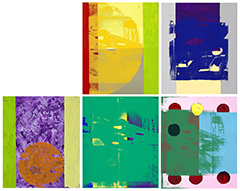German Contemporary Art: Kippenberger and Förg
The focus on international art continues at this summer’s auction of modern art in Copenhagen, where we present two German artists that are considered to be some of the most important names on the newer European art scene. Martin Kippenberger (1953-97) is represented with a series of five works from 1994, while Günther Förg’s (1952-2013) work on the concept of space is fully developed with both lead works, oil paintings, sculptures and ceramics.
Kippenberger’s Recycled Art
Martin Kippenberger comes from the same generation as the group of “young and wild” painters who in the 1980s invaded the art scene across national borders with their highly intense and experimental approach to painting as an artform. Yet Kippenberger distinguishes himself significantly from his contemporaries with his conceptual method and in particular in his rejection of a recognizable or consistent style. Kippenberger’s nomadic oeuvre consists of every imaginable medium – from paintings and sculptures to installations and books. He constantly reuses or recycles his own portrait or lets his own former works be resurrected in later works, seemingly in an endless loop. This is also the case with the series of five paintings up for auction. In terms of motifs, the series builds on the artist's extensive installation "The Happy End of Franz Kafka's America", which was exhibited in 1996 in Denmark. It was also in Copenhagen that the artist created the series of paintings, which is now up for auction.
In other works, Kippenberger’s often recurring self-presentation can remind you of Jeff Koons’ work. The recurring practice is also at play in this series both with a reference to the 1994 installation as well as in the work itself with the five paintings' variation of the installation's motif. Kippenberger’s practice is reminiscent of one of the absolute leading figures within Pop Art, Andy Warhol, who truly sought to break down the concepts of originality, genuineness and authenticity.
Förg’s Mirroring of Art History
Günther Förg graduated from the Academy of Fine Arts in Munich, where he studied under the German artist Karl Fred Dahmen, and there is a kinship to be found in the two’s simplified idiom and work with a very simple image, which in its details proves to be quite refined and alive. Later, Forg himself worked as a professor at the academy while continuing his own artistic practice. In a similar fashion to Kippenberger, Förg also works across many different media, as can be seen in the auction's wide selection of his work.
His idiom is generally non-figurative and minimalistic – an expression which builds on the American art scene of the 1960s, which included names such as Ellsworth Kelly, Robert Ryman and Donald Judd. For Förg, it was a matter of emptying the work for both references to an external reality or the presence of an artist and to make the art an independent reality in the space it occupies. To get to the core of the matter; the minimalist idiom moves from the illusionary space of traditional art into the concrete space in which we move around in. It is a mirror reversal of art history where the work points back at us and the space we are in. We do not look into an illusion of perspective – the object of art must be a physical thing in space and change depending on where we are going. Modernism in its extreme – art for the sake of art!
“The nice thing is that it has such a life of its own”
Förg uses these words to describe one of his favourite materials: lead. He is especially known for precisely these lead paintings, and one of them also belongs among the highlights of the auction. Förg begins to paint on lead in the early 1980s. In the work up for auction from 1995, Förg's minimalist approach cannot be denied, but at the same time he works with transparency and many layers of paint. Copper and steel can be polished and appear completely glossy and flawless, but this is not what holds Förg’s interest in the material. Lead is resistant, it changes and oxidizes – you could almost say that breathes. Therefore, these lead images provide a strong contrast of something vivid and textured compared to the purer minimalist paintings.
Auction: 6 June at 4 pm in Bredgade 33, Copenhagen
Preview: 24-28 May at the same address
View all the moderne art works at the auction
View all the works at the auction
Read about bidding
For further information, please contact:
Niels Raben: 8818 1181 · nr@bruun-rasmussen.dk
Niels Boe Hauggaard: 8818 1182 · nbh@bruun-rasmussen.dk
Annemette Müller Fokdal: 8818 1196 · amf@bruun-rasmussen.dk
Kathrine Eriksen: 8818 1184 · ke@bruun-rasmussen.dk


